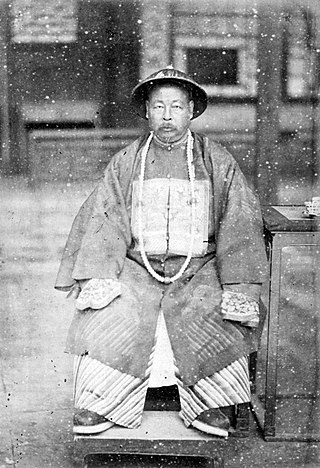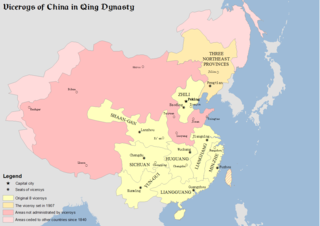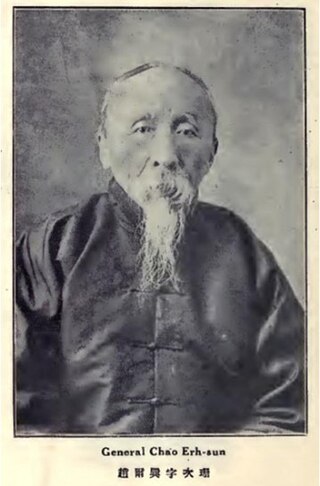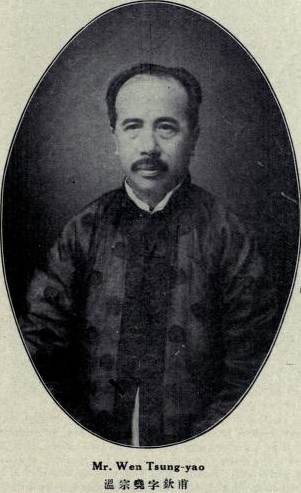Contents
This article needs additional citations for verification .(August 2018) |
| |||||
| Decades: | |||||
|---|---|---|---|---|---|
| See also: | Other events of 1845 History of China • Timeline • Years | ||||
This article needs additional citations for verification .(August 2018) |
| |||||
| Decades: | |||||
|---|---|---|---|---|---|
| See also: | Other events of 1845 History of China • Timeline • Years | ||||

The 1911 Revolution, also known as the Xinhai Revolution or Hsinhai Revolution, ended China's last imperial dynasty, the Qing dynasty, and led to the establishment of the Republic of China (ROC). The revolution was the culmination of a decade of agitation, revolts, and uprisings. Its success marked the collapse of the Chinese monarchy, the end of over two millennia of imperial rule in China and the 200-year reign of the Qing, and the beginning of China's early republican era.

Zuo Zongtang, sometimes referred to as General Tso, was a statesman and military leader of the late Qing dynasty.

Zongdu were high-level officials responsible for overseeing the governors of several provinces in Ming and Qing China. One viceroy usually administered several provinces and was in charge of all affairs of military, food, wages, rivers, and provincial governors within their region of jurisdiction. Viceroys were appointed by and directly reported to the Emperor.

Sheng Xuanhuai was a Qing dynasty Chinese tycoon, politician, and educator. He founded several major banks and universities and served as Minister of Transportation of the Qing Empire. He was also known as Sheng Gongbao.

Ma Jianzhong, courtesy name Meishu, also known as Ma Kié-Tchong in French, was a Chinese official and scholar in the late Qing dynasty.

Cen Chunxuan, courtesy name Yunjie, was a Zhuang Chinese politician who lived in the late Qing dynasty and Republic of China.

The Viceroy of Liangjiang, fully named in Chinese as the Governor-General of the Two River Provinces and Other Local Admirals, in Charge of Military Affairs, Food and Wages, Management of Rivers, and Administration on Nanhe Affairs, was one of eight regional Viceroys during the Qing dynasty. The Viceroy of Liangjiang had jurisdiction of military, civil, and political affairs over then Jiangnan Province and then Jiangxi Province. The position was set up in 1647 and abolished in 1912.

Zhao Erxun, courtesy name Cishan, art name Wubu, was a Chinese political and military officeholder who lived in the late Qing dynasty. He served in numerous high-ranking positions under the Qing government, including Viceroy of Sichuan, Viceroy of Huguang, and Viceroy of the Three Northeast Provinces. After the fall of the Qing dynasty, he became a historian and was the lead editor of the Draft History of Qing.

Guanwen, courtesy name Xiufeng, was a Manchu official, Grand Secretariat, military general, Viceroy of Zhili, Huguang and commander of the Army Group Central Plain during the late Qing dynasty in China.

The Taiping Heavenly Kingdom, or the Heavenly Kingdom of Great Peace (1851–1864), was a theocratic monarchy which sought to overthrow the Qing dynasty. The Heavenly Kingdom, or Heavenly Dynasty, was led by Hong Xiuquan. Its capital was at Tianjing, present-day Nanjing. The unsuccessful war it waged against the Qing is known as the Taiping Rebellion.

Wen Zongyao or Wen Tsung-yao, courtesy name Qinfu (欽甫), was a politician and diplomat in the Qing Dynasty and the Republic of China. In the late Qing era, he belonged to the pro-reform group. In the era of the Republic, he participated in the Sun Yat-sen's Canton Militarist Government. However, during the invasion of Japanese, he was a leading politician in the Reformed Government of the Republic of China and the Wang Jingwei regime, which were puppets state installed by the Japanese. He was born in Xinning, now Taishan), Guangdong.

The Panthay Rebellion (1856–1873), also known as the Du Wenxiu Rebellion, was a rebellion of the Muslim Hui people and other ethnic groups against the Manchu-led Qing dynasty in southwestern Yunnan Province, as part of a wave of Hui-led multi-ethnic unrest.

Duanfang, courtesy name Wuqiao, was a Manchu politician, educator and collector who lived in the late Qing dynasty. He was a member of the Tohoro clan and the Plain White Banner of the Eight Banners.

Late Qing reforms, commonly known as New Policies of the late Qing dynasty, or New Deal of the late Qing dynasty, simply referred to as New Policies, were a series of cultural, economic, educational, military, diplomatic, and political reforms implemented in the last decade of the Qing dynasty to keep the dynasty in power after the invasions of the great powers of the Eight Nation Alliance in league with the ten provinces of the Southeast Mutual Protection during the Boxer Rebellion.

Hu Guangyong (1823–1885) (胡光墉), better known by his courtesy name Xueyan (胡雪巖), was a businessman in China during the latter Qing dynasty. He was active in banking, real estate, shipping and Chinese medicine. He was involved in the salt, tea, clothing, grain as well as the arms trade.
Events from the year 1855 in China.
Events from the year 1874 in China.
Events from the year 1662 in China.

Wei Guangtao, courtesy name Wuzhuang was a Chinese politician who was the Governor of Xinjiang, Viceroy of Yun-Gui, Viceroy of Shaan-Gan, Viceroy of Liangjiang, and Viceroy of Min-Zhe. He was also notable for his military service during the First Sino-Japanese War and Dungan Revolt.

Wang Wenshao, courtesy name Wenqin, was an influential Chinese statesman and military figure during the late Qing Dynasty who advocated for Westernization.